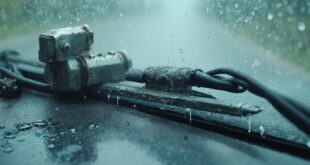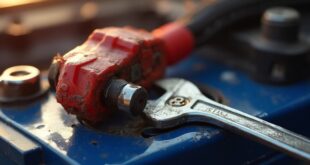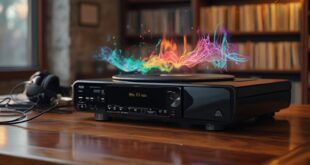If you notice starting problems, flicking headlights, or drained battery issues, you might have loose battery cables. Hot cables or terminals signal excessive resistance, and you shouldn't ignore a blinking instrument cluster. These symptoms can lead to further electrical problems and car troubles. Make sure to regularly check your battery connections to avoid greater issues. Stick around to discover more symptoms and solutions for maintaining your vehicle's battery health.
Starting Problems
When you try to start your car but find it struggling to turn over, a loose battery cable might be the culprit. You may notice that the engine cranks slowly or not at all, despite having a new battery.
This issue often arises from vibrations while driving, which can loosen the connections. If your car doesn't start, it's crucial to check the battery cables first before considering a battery replacement.
A strong battery needs secure connections to function correctly. Ignoring these signs can lead to further problems, so addressing loose cables promptly can save you time and money.
Hot Battery Cables or Terminals
Starting problems can often lead to the discovery of hot battery cables or terminals. If you notice excessive heat when touching the cables or terminals, it's a sign of loose connections.
These connections increase electrical resistance, causing the cables to heat up dangerously. You should avoid handling hot cables, as extreme temperatures can pose safety risks.
Verify the negative cable is properly grounded to prevent overheating. Regularly checking for tight connections can help you avoid these issues and maintain your vehicle's electrical system.
Addressing hot cables early can prevent further damage and verify reliable vehicle performance.
Battery Charging Issues
If you're experiencing battery charging issues, it may stem from loose connections that hinder the alternator's ability to effectively charge the battery.
You might notice the battery warning light illuminating on your dashboard, signaling a problem. Ignoring this can lead to further battery damage and even complete failure.
Consistent charging is essential for battery longevity, and loose cables can disrupt this process. Regularly check your connections to verify they're secure and free from corrosion.
Flicking Headlights
Although flicking headlights can seem like a minor annoyance, they often signal deeper electrical issues, particularly related to loose battery connections.
When your headlights flicker or appear dimmer, it usually indicates an inconsistent power supply. This inconsistency often arises from poor battery connections, which fail to provide steady electrical flow.
You might notice this flickering more when driving over bumps or uneven surfaces. Ignoring these visual cues can lead to more significant problems down the line.
It's vital to check your battery cables and connections to verify they're secure and functioning properly, keeping your headlights shining bright.
Blinking Instrument Cluster
When your instrument cluster starts blinking, it's often a sign that your car's electrical system is struggling to provide adequate power. This flickering can indicate loose battery cables, disrupting the flow of electricity to your dashboard displays.
You might notice these issues more during nighttime driving when the need for reliable lighting is critical. Ignoring this symptom can lead to further complications, impacting your vehicle's performance.
To avoid potential breakdowns, it's vital to check your battery connections promptly. Securing those connections can restore normal operation to your instrument cluster and guarantee a safe driving experience.
Don't overlook this warning sign!
Drained Battery
A drained battery can leave you stranded and frustrated, making it essential to recognize the signs before it happens.
If your vehicle struggles to start or requires jump-starting frequently, it's time to investigate further. Loose battery connections can prevent adequate charging, leading to battery death.
You might notice dimming headlights or flickering dashboard lights, indicating insufficient power. If your battery completely dies, consider using a charger to revive it, but make certain all connections are secure first.
Regularly checking your battery's health can help you avoid this situation and keep your vehicle running smoothly.
Frequently Asked Questions
How Can I Prevent Loose Battery Cable Issues?
To prevent loose battery cable issues, regularly check connections for tightness, clean any corrosion, and verify secure mounting. Performing routine maintenance helps maintain peak performance and can save you from unexpected breakdowns.
What Tools Do I Need to Tighten Battery Cables?
To tighten battery cables, you'll need a socket or wrench set, typically 10mm or 13mm, and a wire brush for cleaning. Safety gloves and goggles are also wise to protect yourself during maintenance.
Can Weather Affect Battery Cable Connections?
Yes, weather can affect battery cable connections. Extreme temperatures can cause metal to expand or contract, potentially loosening connections. Regularly checking and tightening your cables can help maintain a reliable electrical connection regardless of the weather.
How Often Should I Check My Battery Cables?
You should check your battery cables every few months or whenever you notice starting issues. Regular inspections can prevent potential problems, ensuring your vehicle runs smoothly and extends the life of your battery.
What Signs Indicate a Professional Should Inspect My Battery?
If your battery warning light illuminates, you experience starting issues, or your headlights flicker, it's time to let a professional inspect your battery. These signs often indicate underlying problems that need immediate attention.
 Car Service Land Coupons for Oil change, Tires, Wheel alignment, Brakes, Maintenance
Car Service Land Coupons for Oil change, Tires, Wheel alignment, Brakes, Maintenance




